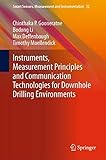Instruments, Measurement Principles and Communication Technologies for Downhole Drilling Environments [electronic resource] / by Chinthaka P. Gooneratne, Bodong Li, Max Deffenbaugh, Timothy Moellendick.
By: Gooneratne, Chinthaka P [author.] .
.
Contributor(s): Li, Bodong [author.] | Deffenbaugh, Max [author.]
| Deffenbaugh, Max [author.] | Moellendick, Timothy [author.]
| Moellendick, Timothy [author.] | SpringerLink (Online service)
| SpringerLink (Online service) .
.
Material type:  BookSeries: Smart Sensors, Measurement and Instrumentation: 32Publisher: Cham : Springer International Publishing : Imprint: Springer, 2019Edition: 1st ed. 2019.Description: XI, 132 p. online resource.Content type: text Media type: computer Carrier type: online resourceISBN: 9783030049003.Subject(s): Electronics
BookSeries: Smart Sensors, Measurement and Instrumentation: 32Publisher: Cham : Springer International Publishing : Imprint: Springer, 2019Edition: 1st ed. 2019.Description: XI, 132 p. online resource.Content type: text Media type: computer Carrier type: online resourceISBN: 9783030049003.Subject(s): ElectronicsDrilling Hydrocarbon Wells -- Instruments for Formation Evaluation -- Instruments for Well Navigation and Drilling Optimization Evaluation -- Logging Tools in Hydrocarbon Wells -- Downhole Communication and Power Supplies to Instruments and Communication Modules -- Fabrication and Packaging of Downhole Instruments -- New Technologies -- Future Outlook and Perspectives.
This book presents a complete review of the unique instruments and the communication technologies utilized in downhole drilling environments. These instruments and communication technologies play a critical role in drilling hydrocarbon wells safely, accurately and efficiently into a target reservoir zone by acquiring information about the surrounding geological formations as well as providing directional measurements of the wellbore. Research into instruments and communication technologies for hydrocarbon drilling has not been explored by researchers to the same extent as other fields, such as biomedical, automotive and aerospace applications. Therefore, the book serves as an opportunity for researchers to truly understand how instruments and communication technologies can be used in a downhole environment and to provide fertile ground for research and development in this area. A look ahead, discussing other technologies such as micro-electromechanical-systems (MEMS) and fourth industrial revolution technologies such as automation, the industrial internet of things (IIoT), artificial intelligence, and robotics that can potentially be used in the oil/gas industry are also presented, as well as requirements still need to be met in order to deploy them in the field.


There are no comments for this item.